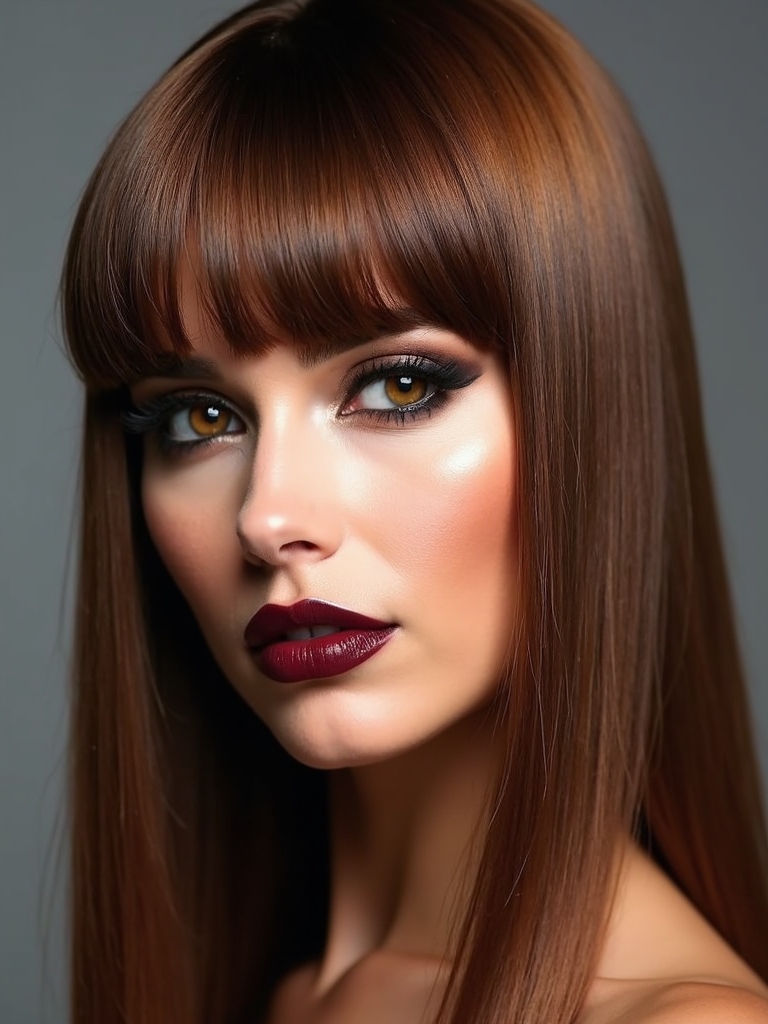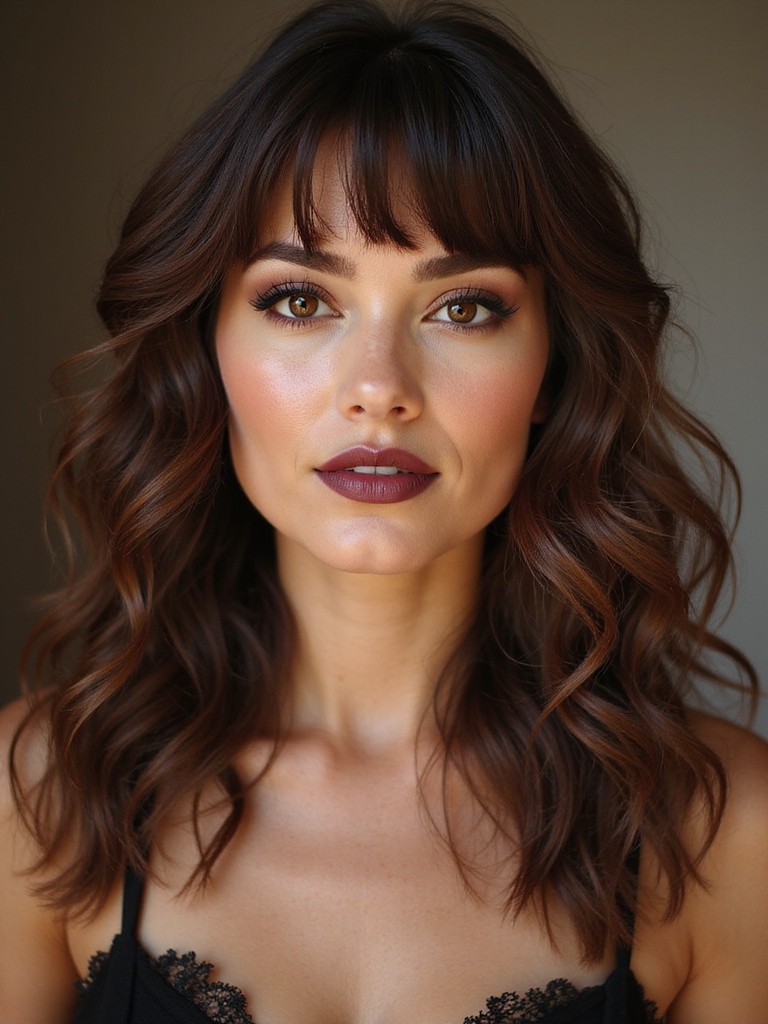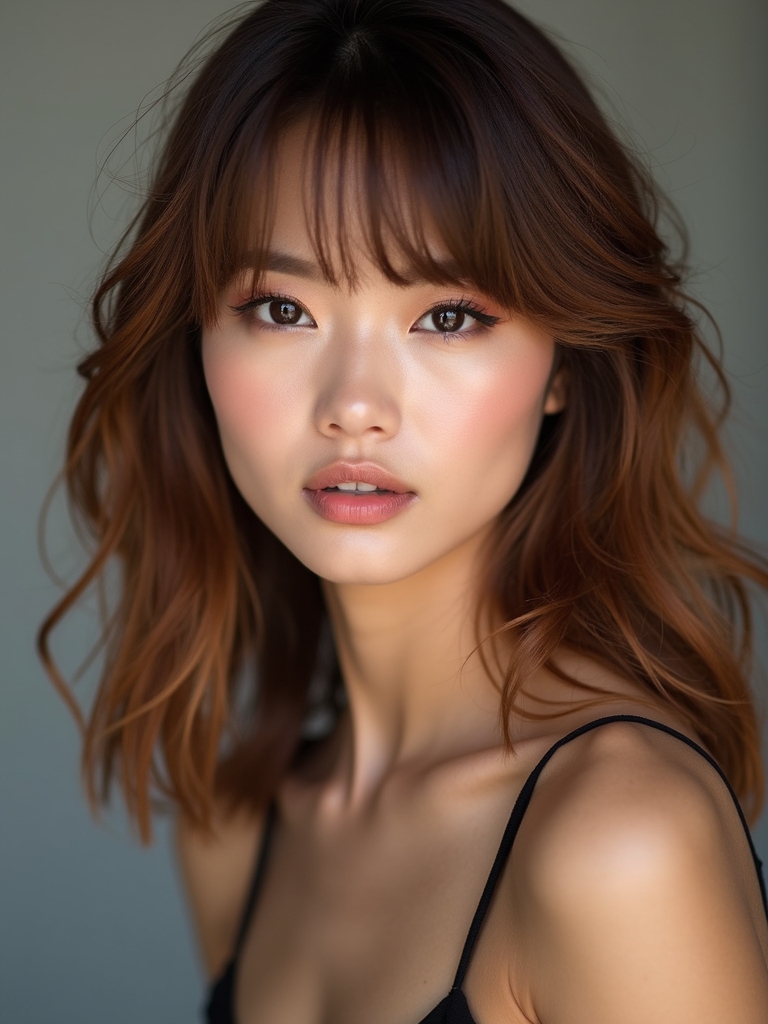I love how curtain bangs can make straight hair look polished without trying too hard. They frame the face, add movement, and—when you care for them right—they catch light and look glossy.
I’ll share simple cuts, styling tricks, and quick care tips that keep the fringe light and shiny, plus fixes for common problems you’ll actually use—so stick around to find the easiest ones.
Why Curtain Bangs Complement Straight Hair

Because straight hair naturally falls sleek and predictable, curtain bangs feel like the perfect personality upgrade — and I say that as someone who loves a low-fuss look.
I find they add movement, frame my face, and soften harsh lines without extra styling. They layer seamlessly with straight lengths, boost texture, and give an effortless, lived-in vibe that keeps mornings simple and chic.
Curtain bangs are especially effective at enhancing face framing and overall balance in straight hair.
Choosing the Right Curtain Bang Length for Your Face Shape

Let’s talk about how face shape basics guide the best curtain bang length for you so your cut actually flatters your features.
I’ll cover chin-length options for shorter faces and how slightly longer pieces can open up a round or square face.
We’ll also look at simple ways curtain bangs can balance a wide forehead without overwhelming your look.
Long bobs pair especially well with curtain bangs because they create movement and frame the face Effortless Long Bob.
Face Shape Basics
When I help someone pick curtain bangs, the first thing I consider is their face shape, since the right length can balance your features and make the whole look feel effortless; think of bangs as a tiny sculptor’s tool that can soften a square jaw, lengthen a round face, or highlight cheekbones.
I suggest shorter, wispy lengths for oval faces, longer sweeping pieces for rounder ones, and angled layers to flatter square shapes.
Curtain bangs are a versatile way to frame the face and create movement with Hair Curtain Bangs.
Chin-Length Options
If you’ve got your heart set on chin-length curtain bangs, I’ll help you fine-tune the exact stop point so they flatter your face shape instead of overwhelming it.
I recommend stopping at the chin for oval faces, slightly below for long faces, and a touch above the chin for rounder shapes to create length.
We’ll tweak thickness and parting to keep balance.
These bangs pair especially well with long layers to add movement and prevent heaviness.
Balancing Forehead Width
You’ve got the chin-length options pinned down, so now I want to help you think about forehead width and how it changes the ideal curtain-bang length.
I’ll guide you to balance proportions so bangs flatter, not overwhelm.
- Narrow forehead: fuller, longer parting
- Wide forehead: shorter, face-framing pieces
- High forehead: lower, softer sweep
- Low forehead: airy, lifted center
For sleek, straight hair, consider how curtain bangs interact with overall shine and layering to enhance effortless curtain bangs and a polished finish.
Tailoring Curtain Bangs to Different Straight Hair Textures

Though straight hair might look simple at first glance, I know that its subtle texture changes everything when you’re choosing curtain bangs.
I tailor advice for silky, coarse, and fine strands—silky needs lighter layering, coarse benefits from weight to control frizz, fine gains volume with blunt inner edges.
We talk styling product choices and drying tricks so your bangs behave beautifully every day.
Best Cutting Techniques for Seamless Curtain Bangs

I start every curtain-bang cut by mapping the hair’s natural fall and face shape so the results look effortless from day one; that initial assessment tells me where to place the part, how much weight to remove, and if to angle the ends for softness or keep them blunt for impact.
I use precise point-cutting, slide cutting, tension control, and soft layering to sculpt movement:
- Point-cut ends for feathered texture
- Slide-cut to remove bulk subtly
- Cut on natural part for symmetry
- Light layering to encourage curtain swing
How to Blend Curtain Bangs With Long, Straight Hair

I’ll walk you through how to place your part and position curtain bangs so they frame your face without looking pasted on.
I’ll share simple layering tricks that blend the bangs into long, straight lengths for a seamless finish.
Then we’ll cover quick styling moves that add natural movement and keep the look airy all day.
Parting and Placement
When I place curtain bangs with long, straight hair, I focus on the part first—it’s the single choice that makes them look intentional instead of pasted on.
I pivot hair around that line, balancing face shape and hair density.
Small shifts change everything, so I tweak until it feels natural and framed, never forced.
- test center vs off-center
- gauge forehead width
- mirror both angles
- adjust subtly throughout day
Seamless Layering Tips
Because layering is what makes curtain bangs look like they grow out of your hair, I start by mapping the flow from fringe into the lengths so nothing reads blunt or tacked on.
I snip soft, face-framing layers, point-cut ends, and feather toward the mid-lengths to blend. Tiny, controlled layers keep a seamless progression that looks natural and effortlessly polished.
Styling for Movement
Let’s break down how to get curtain bangs to blend and move with long, straight hair so they never look stiff or pasted on.
I show simple tricks that keep edges soft, encourage movement, and make daily styling quick and playful.
- Blow-dry with a round brush, rolling away from the face
- Use lightweight texturizing spray
- Finger-comb for separation
- Finish with a shine serum
Styling Tools That Make Curtain Bangs Shine

If you want your curtain bangs to look effortlessly salon-fresh every day, the right tools make all the difference — and I’ll walk you through the essentials I actually use.
I swear by a lightweight paddle brush for smoothing, a small round brush for shaping, a fine-tooth comb for parting, and a microfiber towel to reduce frizz.
Add a shine spray for polished finish.
Heat Styling Tips to Preserve Straight Hair Health

When I style my curtain bangs I stick to lower heat settings so the hair stays smooth without getting fried.
I always spray on a lightweight heat protectant first to shield the strands and lock in shine.
Believe me, small adjustments like these keep your bangs looking fresh and healthy longer.
Use Lower Heat Settings
Because my goal is to keep your curtain bangs sleek without frying them, I dial down the heat on my straightener and blow dryer every time I style. Lower settings tame frizz, preserve shine, and still give shape without damage. I listen to my hair and adjust by feel.
- Start low, test a strand
- Use slower passes
- Focus on roots briefly
- Finish cool
Shield With Heat Protectant
Spritzing on a heat protectant is my non-negotiable step before I touch a hot tool — it forms a lightweight shield that helps prevent breakage, split ends, and dullness while keeping my curtain bangs sleek.
I spray evenly, comb through, then style. It never weighs hair down, boosts shine, and gives me confidence that my bangs stay healthy between trims — simple, fast, effective.
Lightweight Products That Add Shine Without Weight

I reach for lightweight shine products when I want curtain bangs that look glossy without getting limp — they boost radiance and tame frizz while keeping my hair airy.
I pick formulas that vanish on application, add subtle glow, and won’t weigh my fringe down.
My favorites:
- Water-based shine serum
- Lightweight hair oil (micro-drop)
- Shine spray with UV defense
- Silicone-free gloss mist
Quick Daily Routines for Polished Curtain Bangs

Now that I’ve got lightweight shine products in my kit, I keep a simple daily routine to make my curtain bangs look polished in minutes. I mist a tiny bit of shine spray, smooth bangs with my fingers, and quick-blow with a round brush for shape.
If needed, a dab of cream tames flyaways. Fast, repeatable, and keeps them fresh all day.
Nighttime Care to Keep Bangs Smooth and Frizz-Free

Usually I tuck my bangs away at night so they wake up smooth and frizz-free; a tiny nighttime routine makes mornings effortless.
I sleep on a silk pillowcase, loosely clip bangs back, and apply a dab of lightweight serum to ends. Little steps keep shape and shine without crunch.
- Silk pillowcase
- Loose clip or pin
- Tiny serum
- Cool air-dry before bed
Freshening Up Curtain Bangs Between Salon Visits

If my curtain bangs start looking a little limp or out of shape between salon visits, I reach for a couple of quick fixes that bring them back to life without a trip to the chair.
I mist roots with dry shampoo for instant lift, smooth ends with a tiny drop of serum, and blast a round brush with a blow dryer for soft, face-framing bounce.
Transitioning From Full Bangs to Curtain Bangs

Keeping curtain bangs looking fresh between appointments is great, but sometimes I want a more dramatic change — like moving from full, heavy bangs to that softer, face-framing curtain look.
I eased into it slowly, trimming center parting, layering sides, and using heat to train the fall.
Tips I loved:
- Start with a long center part
- Snip into layers gradually
- Blowout with a round brush
- Use light texturizer to finish
Celebrity Inspiration for Straight Hair With Curtain Bangs

Who inspires me most for straight-hair curtain bangs? I love how celebrities like Alexa Chung and Lily Collins make that soft, face-framing look feel effortless and modern.
Their sleek, glossy strands and casually parted bangs give me style goals without drama. I watch photos, note proportions, and adapt their shapes to my face, keeping things simple, wearable, and confidently chic.
Addressing Common Concerns: Grease, Flatness, and Breakage

Since curtain bangs sit right at the hairline, they’re prone to greasiness, limpness, and breakage—but you don’t have to accept those problems as inevitable.
I deal with them by tweaking routine, products, and tiny habits that protect shine and body.
- Dry shampoo on rotation
- Lightweight conditioner application
- Gentle detangling and heat control
- Night silk scarf to reduce friction
When to See a Stylist for Maintenance and Restyling

I like to check in with my stylist every 6–8 weeks for a tidy trim to keep curtain bangs sitting just right.
If the shape starts to lose its sweep or my part drifts, I book a reshaping session so it doesn’t turn into a daily battle.
Knowing the trim frequency and signs you need a reshape saves time and keeps the look fresh.
Trim Frequency Guide
Usually I get my curtain bangs trimmed every 6–8 weeks, and you’ll find that schedule keeps the shape fresh without overcutting.
I check growth, split ends, and how bangs sit with layers—then book a quick tidy. Small trims keep them versatile and healthy.
- Quick cleanups prevent heaviness
- Fix stray pieces between cuts
- Refresh face-framing length
- Preserve natural movement
When to Reshape
Often I wait until the curtain bangs stop flattering my face or start acting differently before booking a reshape — and that’s the cue to see a stylist for maintenance or a restyle.
I go when the part drifts, volume collapses, or grown-out layers blur the shape.
A pro refreshes the silhouette, tweaks length, and sets direction so my bangs feel intentional again.
I’m obsessed with how curtain bangs instantly polish straight hair — they’re soft, flattering, and surprisingly low-effort once you find the right length and technique. Keep them glossy with a light heat protectant, a micro-drop of oil or water-based shine serum, and silk nighttime care.
Trim every 6–8 weeks and see your stylist if shape or damage shows. Try small tweaks before big chops; you’ll love the framed, modern look they give your face.







